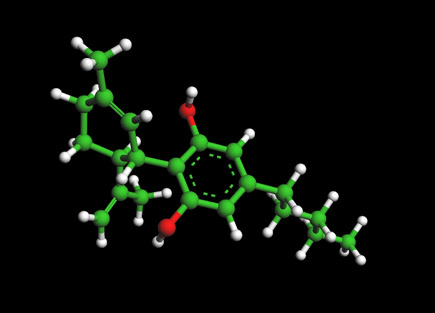 It has long been established that cannabis can effectively treat glaucoma, a condition that damages the optic nerve and can lead to blindness. However, new research indicates that while THC helps fight glaucoma, its cousin cannabinoid CBD has the opposite effect—and could actually counteract the efficacy of THC.
It has long been established that cannabis can effectively treat glaucoma, a condition that damages the optic nerve and can lead to blindness. However, new research indicates that while THC helps fight glaucoma, its cousin cannabinoid CBD has the opposite effect—and could actually counteract the efficacy of THC.
Perhaps the most widely known use of medical marijuana is to treat glaucoma. Research going all the way back to the 1970s shows that THC, the psychoactve cannabinoid in marijuana, alleviates intraocular pressure, a key contributor to glaucoma. But a study from researchers at Indiana University now finds that CBD—the non-psychoactive cannabinoid currently the subject of intense interest by the medical community—may actually worsen the interocular pressure that leads to the disease.
The study released this month in the journal Investigative Ophthalmology & Visual Science contradicted the widespread assumption that CBD is essentially neutral where glaucoma is concerned .
"It has been known for nearly 50 years that cannabis and the psychoactive constituent Δ9-tetrahydrocannabinol (THC) reduce intraocular pressure (IOC)," the study authors wrote in an abstract summing up their findings. "Elevated IOP remains the chief hallmark and therapeutic target for glaucoma, a major cause of blindness... Cannabidiol (CBD) is a second major constituent of cannabis that has been found to be without effect on IOP in most studies."
But the abstract quickly kicks the conventional wisdom to the curb: "Far from inactive, CBD was found to have two opposing effects on ocular pressure, one of which involved antagonism of tonic signaling. CBD prevents THC from lowering ocular pressure.”
"This study raises important questions about the relationship between the primary ingredients in cannabis and their effect on the eye," research team leader Alex Straiker of the IU Bloomington College of Arts and Sciences told the medical news site MDLinx. "It also suggests the need to understand more about the potential undesirable side effects of CBD, especially due to its use in children."
The study, which was carried out on mice, found that while THC caused a drop in eye pressure for 30% of subjects, lasting up to eight hours, CBD caused an increase in pressure inside the eye of 18% of subjects for at least four hours after application.
One surprising result of the study is an apparent role for gender in how effective THC is at relieving interocular pressure. Male mice experienced a drop in eye pressure of nearly 30% eight hours after exposure to THC alone. A lower pressure drop of 22% was observed after four hours in male mice. For reasons not entirely clear, the effect was found to be weaker in female mice—they experienced a pressure drop of only 17% after four hours, with no difference seen after eight hours.
"This difference between males and females, and the fact that CBD seems to worsen eye pressure, the primary risk factor for glaucoma, are both important aspects of this study," Straiker told Science Daily. "It's also notable that CBD appears to actively oppose the beneficial effects of THC."
Relevant cannabinoid receptors identified
The IU researchers also succeeded in identifying two specific neuroreceptors—dubbed CB1 and GPR18—by which THC impacts interocular pressure. This is a significant breakthrough apart from the findings about CBD and the gender difference: another addition to the mounting knowledge of cannabinoid receptors that can explain how these compounds work their seeming magic.
"There were studies over 45 years ago that found evidence that THC lowers pressure inside the eye, but no one's ever identified the specific neuroreceptors involved in the process until this study," Straiker told Science Daily. "These results could have important implications for future research on the use of cannabis as a therapy for intraocular pressure."
Summing up the study's findings in an interview with Medical Research website, Straiker first issued sobering words for the fast-growing ranks of CBD-enthusiasts: "There is a real possibility that CBD elevates ocular pressure and therefore the risk of glaucoma as a side-effect. This is significant given the widespread (and growing) availability of CBD and its recent FDA approval as a treatment for Dravet's Syndrome." That's a reference to the recent Food & Drug Administration thumbs-up for Epidiolex, a CBD-based pharmaceutical used to treat severe forms of epilepsy, such as Dravet's.
But secondly, he offered more encouraging news for use of cannabis as medicine. The study got results from topical application of THC—something the American Academy of Ophthalmology has not yet recognized as effective: "[T]he sex-dependence is significant in and of itself but also because the current AAO position that topical THC is ineffective as a glaucoma therapy is based on four studies, three of which were small mixed-sex subject pools. If the sex-dependence holds for humans, then it is possible that those studies yielded a false-negative result."
This IU study may loan credence to the perception that the health benefits of THC are being overlooked amid the current CBD-mania. It also gives a sense of a window just opening on our understanding of how cannabinoids interact with the human organism, and how this knowledge can be harnessed by science.
Cross-post to Cannabis Now
Image: World of Molecules







Recent comments
2 weeks 6 days ago
6 weeks 4 days ago
10 weeks 4 days ago
11 weeks 2 days ago
21 weeks 2 days ago
25 weeks 3 days ago
26 weeks 3 days ago
26 weeks 3 days ago
47 weeks 4 days ago
51 weeks 5 days ago